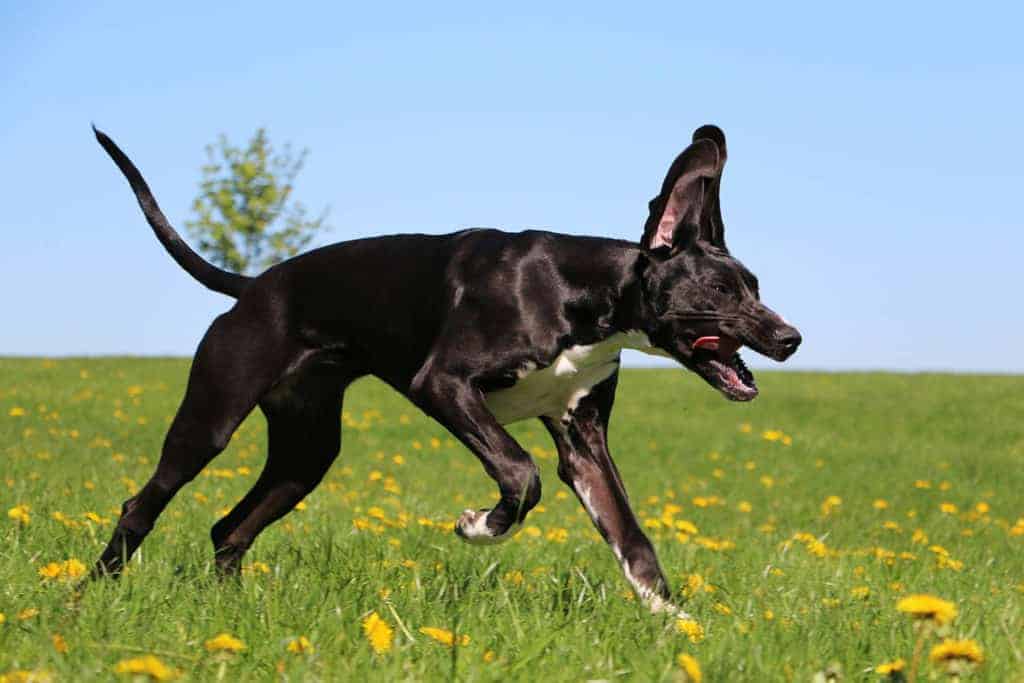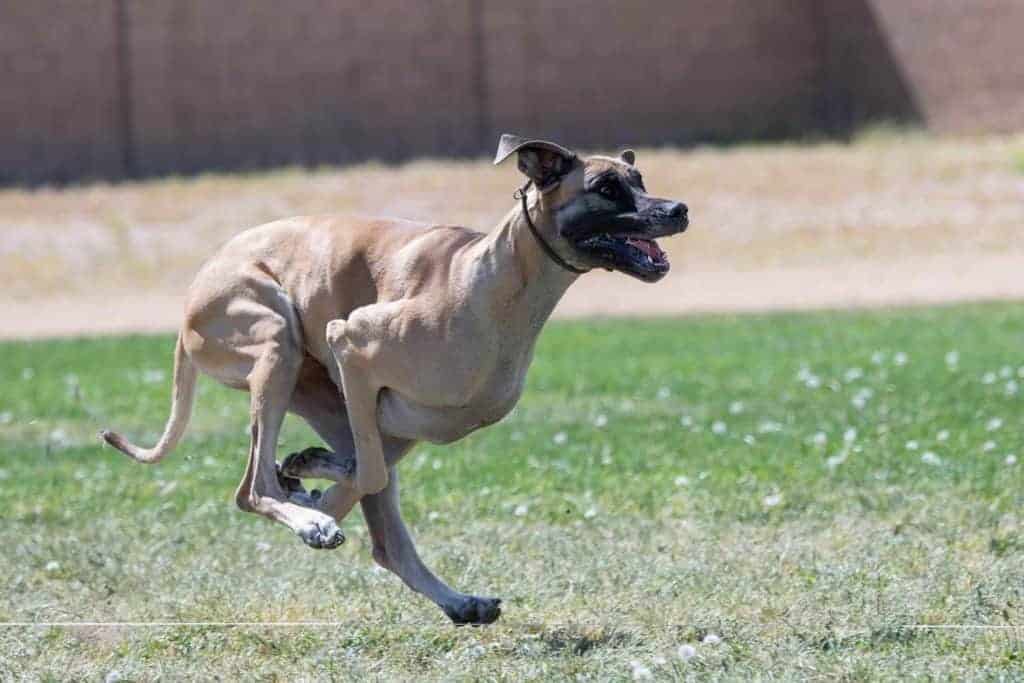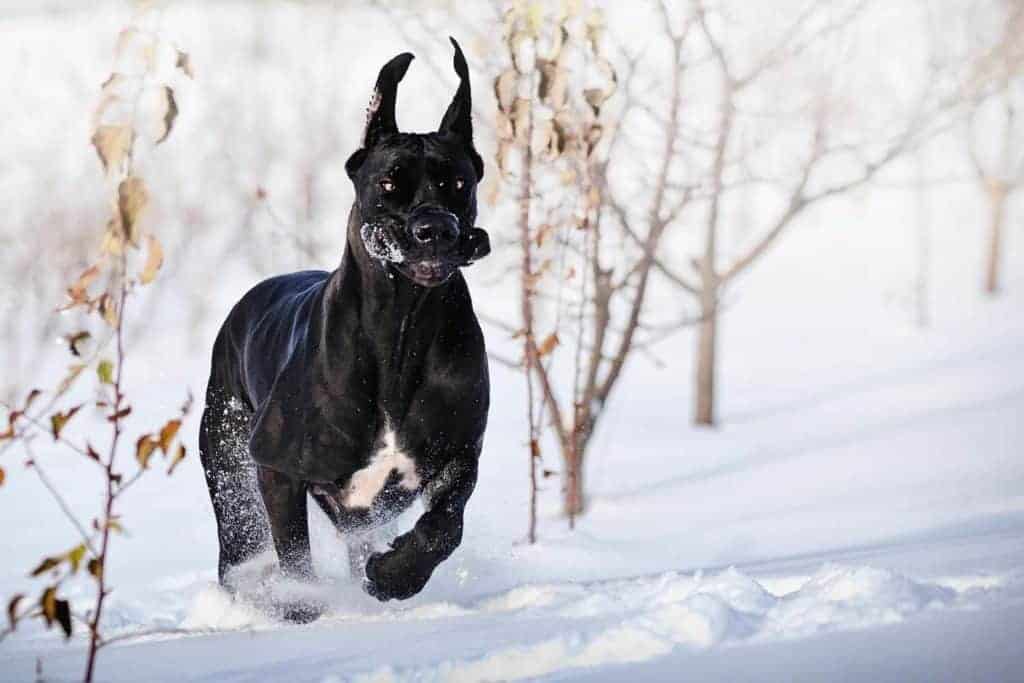
Ever see a Great Dane run and wonder how fast they were actually moving? Ever wondered just how and why they’re as impressively fast as they are? Here is everything you’ll need to know about a Great Dane’s speed.
How Fast Can a Great Dane Run? At the absolute fastest, a Great Dane is capable of running up to 30 MPH (48.3 KPH). They are the second fastest dog breed in the world, in fact, beaten only by the Greyhound/Whippet breed. Just because they are capable of running at that seemingly breakneck speed doesn’t mean that they are just born that way. Just like any professional athlete capable of maximizing their body’s limitation, a Great Dane must be trained to reach that top speed. Below is everything you’ll need on training feasibility, timing, the details on how a Great Dane runs, and how to make the most out of the training itself.
Is it hard to train a Great Dane?
While some dogs absolutely love training and can’t wait for you to teach them new tricks and help them be better versions of themselves, Great Danes are not amongst them. Training Great Danes takes a lot of patience and time because they are well-known for being stubborn. Just because you want your doggo to run as fast as a car doesn’t mean that he’s going to want to do it, after all!
Training a Great Dane will take a lot of discipline and working hand in hand — er, hand in paw — with your pooch to make sure that it is successful, productive and, of course, safe. While many people do train their Great Danes as runners, you’ll need to dedicate some serious time and education to do it the right way.
When can I start training a Great Dane?
To beat that bull-headedness, many pet parents make the mistake of trying to train their Great Danes right from puppyhood, on top of all of the other basic commands, of course. However, according to the AKC, overdoing it with extreme exercise puts them at risk for health issues in the long-term.
As far as Great Danes are concerned, the best course of action is to wait until they are at least 2 years old. This doesn’t include basic training, normal walking and playtime, of course. These are all considered standard puppy training and dog-related life. However, the age of 2 years as a minimum is recommended for any kind of running training.
Most of this comes down to two reasons. The first is that a puppy is still developing and finishing their growth right up to (and even past) their 2nd birthday. Since their body is still developing, training before it is done developing can injure them and weaken them bones and joints before they’ve even finished growing. Allowing their bones and joints to mature completely puts them in prime condiment for professional running training. Not only does this prepare them safely, but it also makes sure that they don’t have any long-term health issues so young in life.
Another detail to keep in mind on timing is that Great Danes are prone to issues such as joint problems and brittle bones. You can both trigger and/or exacerbate these conditions by training him too hard, too early. Since this leads to expensive vet appointments, surgery and even pain medications, this is something to take seriously for the health and comfort of your doggo.
Can Great Danes run long distances?
If you’ve ever seen a Great Dane take off across a field, you may already know the answer to this question! But, yes, Great Danes are more than capable of running long distances. However, the “how” of this situation is what makes it so curious.
Technically, Great Danes are not exactly your typical long-distance running dogs (more on that in a moment). That is, they’re not exactly great candidates for a doggie cross-country team. Their ability to run long distances is simply because of their sheer size. They can cover a lot of ground in a short time because their legs are long and this gives them an impressive stride.
All things aside, Great Danes aren’t any better than standard breeds such as Golden Retrievers when it comes to running distance or endurance. They rank higher just because they are so much bigger.
Their incredible ability to run is what made them so popular throughout history. Used as hunting dogs to help hunt those large wild animals such as boars and bears, their speed and distance helped humans capture these animals that were so much larger and faster than them.
How is a Great Dane so fast?
There’s no question that seeing a Great Dane run at full speed is absolutely mesmerizing. How, exactly are they able to run so fast? Again, it all comes down to their size. They are large dogs and this helps them to cover more ground in fewer strides.
That being said, they also have impressively long legs. In terms of proportions, Great Danes are well-known for these knobby, thing and gang legs that often look hilarious as your doggo grows into them! These legs allow for longer strides, naturally.
Another breed-specific aspect you’ll notice is that they are also bred exclusively to be fast. They are aerodynamic and relatively thin, muscled and agile dogs. All of these details make them faster and than most dogs as well.
All in all, from size to proportions, and specific trait to the Great Dane breed, these doggos are certainly amongst the fastest and best runners around.

Training Great Danes for fast and long-distance running
If you’re interested in seeing what your doggo can do when he is trained properly, you’ll want to be ready with the right training tips and supplies to make the most out of it. Here are the key concepts to focus on to help training stay on track, healthy and safe.
Consistent schedule
Since you now know that Great Danes are particularly stubborn, you’ll need to put together and enforce a consistent schedule for the actual training itself. Your schedule should be, well, scheduled to start out slow and then increase throughout its window.
Try to keep your consistency on the timing of the training as much as the actual sessions themselves. That is, if you normally train him on Mondays, Wednesdays and Fridays from 3-4PM, try to keep that is consistent as possible. Not only will he often look forward to bonding and running with you, but he’ll also know to expect it. This can make working with this stubborn and opinionated breed much easier all around!
Right diet
Just like humans, you’ll also need to get him on the right diet to help fuel his body and give him both the physical energy and the capacity to gain more muscle mass as he trains and gets stronger with your guidance.
You’ll need to focus on a healthy diet, of course, with no table scraps or excessive treats. You’ll also want to focus on healthy, top-quality dog food as well! Keep in mind that a Great Dane eats about 10-12 cups a day (2.3-2.8 liters), so you may find that the cost of the food does add up in a hurry! To keep his health top of mind, you will also want to source this food exclusively from his vet to ensure that he’s getting all of the right health sources of low protein and vitamins and minerals he’ll need to keep him strong and healthy while training.
Prioritize bone health
Either through just the right food alone, through supplements that are vet-approved and prescribed, or some combination of details, you also have to really prioritize your Great Dane’s bone health. Since you know that they tend to have brittle bones, to begin with, being as proactive to those potential issues helps strengthen them preemptively and also jeeps the risk down during the intense training that you’re giving him.
Be careful with the pacing of your Great Dane’s training
Once your dog adjusts to training, you may find that he loves it so much, he’s eager to go further than you had allowed in a certain session. Since Great Danes are loving and kind towards their favourite humans, they enjoy it for quality time spent with you as much as the actual running and training itself.
But, this is where you have to be a responsible pet parent before a dog trainer! Since Great Danes are so prone to issues with their joints and bones, you have to be very careful and gradual with your pacing. If you only planned on having him run 3 miles (4.8 kilometres) in that sessions, that is your end goal. Even if you know he wants to run more, cap it there.
With this in mind, you’ll want to make sure that you are using the right training plan, too! You can find all sorts of Great Dane training plans for running, but make sure that your vet signs off on the one that you go with. Not only can they determine a bad one from a good one, but they’ll also take into consideration whether it’s a good plan for your doggo or not. After all, there is no “one size fits all” for training, and this includes your pooch!
How to take care of Great Danes while training
Just like with a human or any other kind of “professional athlete” in the animal world, you’ll want to take proper care of your Great Dane while he is going through his training program. Here are some of the key concepts to keep in mind.
Keep him in good health
A healthy pooch is going to be a strong pooch. You’ll want to make sure that he is not underweight or overweight. You’ll need to make sure that he eats enough healthy training food and not too many treats or table scraps.
You’ll also need to remember to keep his mind as healthy as his body, with plenty of time spent playing with toys and his favourite human outside of training.
Then there’s the proper immunizations, regular check-ups that all dogs need, and a neuter or spay surgery as well.
All of this will play a role in keeping him in his top possible peak condition when you start your training.
Get a physical check-up before starting
No matter how excited you are and no matter how eager you know your Great Dane is to hit the track, you’ll need to make sure that he is considered to be fit for duty. This means a thorough check-up at the vet, including blood work and anything else that your vet recommends to get a full and complete picture of how he’s doing. He or she will then make a professional recommendation on whether or not your doggo is a good candidate for training or not. If all checks out, you can safely start training with the right program that they, too, approve.
Keep your vet in the loop
Throughout the training process, you’ll want to keep your vet in the loop as well. Regular sessions, taking their advice on food and other parts of their diet is also important. Remember that your vet is a professional in proper and wholesome dog care. This means that you should always listen to them on any recommendations that they make, even if they do decide that perhaps your dog should stop training or never start at all to begin with. Your dog’s health should always come before anything else, after all, right? Exactly.

A few reminders when training your Great Dane
As you start in on your exciting new training schedule for your fast and furious Great Dane, there are a few general reminders to keep front-of-mind before, during and after training sessions themselves.
Make sure you know how to train them
Don’t make that face! Dog training is a serious job and it’s different from just basic puppy training. Professional athletes have dedicated personal trainers, don’t they? Exactly.
You may not need to hire a professional dog trainer to help your dog learn how to run at his top speed, but you will want to put some time and effort into learning about how dog training works, how to develop a good schedule (or adjust one that you find online), and all sorts of other training information.
You should also focus your attention on training exclusively for Great Danes. This can make the customization process much easier and it also gives you the satisfaction and comfort to know that you are going with a training schedule and technique that others have used effectively and safely with their own doggos!
Give them off days
Energy level and attitude aside, your Great Dane needs rest days just like anyone else who is looking to train. No matter how excited they might be to get out there (same goes for you), you’ll want to make sure that they have rest days purely for their body’s sake. Their muscles, joints, bones and cardiac systems all need time to stretch, improve, and then rest again. This helps them be stronger over time as well, making for a much more dependable star athlete!
Pay attention to their signs
Remember that Great Danes are not really intended to be race track dogs. Sure, they are used in hunting, but they’re not intended to be kept in top peak running condition all year-round. If your doggo is showing signs that they are tired or sore, make sure that you listen to those and stop or adjust training.
The same thing goes for emotional and mental needs. If your doggo, as stubborn as he is, just doesn’t want to run or doesn’t like to run, don’t force him to do so. While resistant at first, most pooches will adjust to running training as they get used to the schedule (here is that consistency thing again). But, maybe your Great Dane is the exception. Maybe he hates training and just doesn’t want to do it.
As a pet parent, you need to curb your own excitement for your Great Dane to “reach his full potential” and remember that you must parent him first, and coach him second. Not only will he resent the training and running in general, meaning he most likely won’t reach his top speed unless he is under duress, he will also associate you with negativity and even fear because he is being forced to do something he doesn’t want to do. It hurts, right?
Remember that age factors in
While you don’t want to train him too young, of course, his upper age also is important to remember as well. Great Danes, unfortunately, don’t often live as long as most breeds due to their size (earning them the nickname of the “heartbreak breed”). If you get your doggo later n his years, training to be a runner may not be realistic since his bones and joints are already aged a great deal. Your vet will be able to tell you more about this, however.
There is no question about it: your Great Dane is an impressive runner. Whether you want to see it for yourself or give your Great Dane a chance at doggie stardom, training may be an option to consider! Just keep these pointers and tips in mind to keep everyone safe and healthy in the short and long-term.
